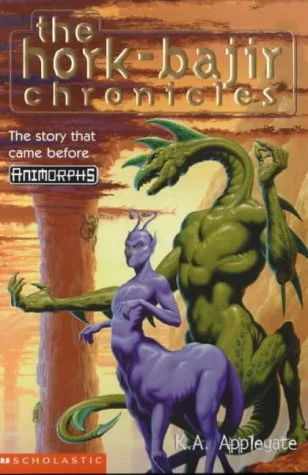Hey, remember how I gave that list, ‘five reasons you shouldn’t read Animorphs?’ The ways that the books aren’t necessarily fully transitive to your experiences now, and that doesn’t mean that you should necessarily take my love of the series to heart and follow through on it? Maybe then I should follow that up with a good way to ease yourself into the story, or some sort of reading list that skips awkward bits?
Or, and hear me out, I could talk about one book in the franchise, that occurs near the tail end of it, and is both the earliest point in the narrative and a standalone science fiction story and a deep lore dive that features no human characters at all.
Let’s do that one.
Let’s do the incomprehensible one.

The Hork Bajir Chronicles is a book in the Animorphs franchise, a series of science fiction novellas from the 1990s released monthly by KA Applegate, published by Scholastic and marketed like drugs for tween nerds. The basic premise is some ordinary 1990s teenagers in a variety of different social classes and race groups, selected by pure random chance (sort of) when after school one day, an alien drops out of the sky, explains to them that Earth is under attack by body-puppetering alien slugs called Yeerks, and that not only can anyone be one of their agents, but also their principal and one of their older brothers already are, and then he gives them special powers, then dies in front of them.
Wait, ‘dies’ kinda undersells it.
Then the commander of the slug aliens turns up, turns into a huge fangly monster, and bites the good alien in half and eats him while the teens watch.
That’s how this story starts.
Anyway, while there was monthly books in this series that followed the narrative of this crew of teenagers and their eventual secondary friends, there were also a handful of ‘Chronicles’ books, which were standalone narratives, focusing on secondary parts of the narrative that weren’t necessary, but still had a fun story there. There’s the Andalite Chronicles (which tell you the backstory of the alien that got et), Visser (which tells you the backstory of the brain-piloting slug parasite alien that did the eating), the Ellimist chronicles (which tells you the backstory of why those two aliens were there at that point in time), and then this, the Hork-Bajir chronicles.
This is about the Hork-Bajir.

What’s a Hork-Bajir? A Hork-Bajir is an alien species from the planet Sector 5, RG-21578-4, or as the Hork-Bajir call their planet, ‘what?’ They’re about seven feet tall, brown-grey, have long, serpentine necks, beaks, clawed feet like a dinosaur or a bird, a tail for balance and apparently just the gnarliest boney knives all over, as a sort of ‘Wolverine on Everything Day.’ They have lightning fast reactions, and are extremely strong. They’re not renowned as intellectual giants as a culture, with adult Hork-Bajir being ‘about as smart as a child.’ That doesn’t matter when you first meet them because they are first introduced under the control of those alien brain slugs, which indicates that they have, at the least, a brain sophisticated enough to make a useful host for one of the brain-slugs.
The Hork-Bajir are shock troops, enormous brutes who can mess things up real bad. They breed slow, so they can’t be used as a general all-purpose host body, and they don’t blend in to human society – so you only see them when they’re there to guard something underground or out of the way. Then you learn, over the course of the series, and most fully here in this book, that Hork-Bajir are absolutely the opposite of this fearsome impression.
Hork-Bajir eat bark, and that’s why they have the beak, claws, and blades. They’re to carve chunks of bark off the trees. They’re so big and agile because they’re arboreal in a world with enormous trees, and they breed slowly because their primary defense mechanism is to avoid conflict. They jump and climb and run, and that’s why they have the impressive musculature and reflexes. They’re also really simplistic mentally, but once every few generations, they have one called a Seer, who’s super intelligent, and they deal with any complex problems the Hork-Bajir can’t handle, set up some systems that can last the community, then die.
And that’s kind of how almost all alien life is handled in Animorphs. You learn that the Hork-Bajir are nothing like how they look, which is a recurrent theme in the story of the Animorphs. Things that look like A are actually B, and how the world is always more complicated than it looks, which plays into the fact these are books for kids approaching puberty and the transition point in their lives.
Anyway, so that’s what you find out about the Hork-Bajir in this book, at least until you meet the Arn.

What’s an Arn?
Look, there is a narrative here in this book, it’s just that the actual narrative is… uh… we’ll get to it. It works by telling you a familiar story, and then it ramps off the rails when it becomes clear that the Yeerks are going to invade the Hork-Bajir homeworld and take the Hork-Bajir as hosts, leading to an adventure exploring avenues of escape, which then introduces you to another sapient inhabitant of the Hork-Bajir homeworld: The Arn.
Arn are quadrapedal tailed flightless? I think? Bird people that have to live in narrow walkway houses on winding pathways on cliffsides over deep subterranean magmatic vents that exude such enormous heat you don’t need to be afraid of falling off and hitting the ground, because you’ll die and be vaporised by the heat before impact. They are biological manipulators, masters of their craft, and very aware of the importance of a balance in the ecosystem. They need the ecosystem with the big trees to keep going to keep the atmosphere and the climate they way they are, and so they made the Hork-Bajir.
They made the Hork-Bajir.
They made the Hork-Bajir to literally maintain the ecosystem. They were nonviolent, so they wouldn’t pose a threat to anything else in the ecosystem and would preserve their own resources. They were communal, so they’d tend to the bark in an area and move on, rather than spread out and tend to the forest unevenly. And Hork-Bajir weren’t smart, because… there was no utility to them being smart. There was literally no reason to design this sapient race to be smart enough to do things like establish civilisation and cultivation because that wasn’t what they were for.

What about the rare smart Hork-Bajir?
Ahhh, they’re a bug. A sorting error. An off-by-one. An overflow. Every thousand Hork-Bajir or so, one gets to be clever, and that was deemed an adequately non-intrusive bug to ship when they released a sapient species unto the world. The genius Hork-Bajir is like Neo from that unalloyed cyberpunk classic The Matrix Revolutions: A glitch in the system whose impact is minor enough that the person tasked with fixing it filed it as ‘works on my machine’ and set it to deploy.
The Arn aren’t… like, apologetic about this? From their perspective, space travel is boring and it is way better and more fun to just do everything with grown biological nonsense, including self-augmentation, so the Hork-Bajir’s level of sapience is never really seen as a moral quandrary for them, nor really is their long-term health (at least, until much later, in the Arn’s final appearance but that’s not in this book). They made the Hork-Bajir, and the Hork-Bajir are desireable hosts for the Yeerks, and that means that the Yeerks are going to have an amazing shock trooper force that they can use to conquer other planets and the Andalites are now going to uh, genocide the Hork-Bajirs to try and contain the Yeerks.
And again: This is the fate of a culture that was created to have the traits they do, by an uninterested precursor race.
As for the Arn’s part in the exchange against the Yeerks, well… they tried to Switzerland their way out of the whole affair. They didn’t want to fight the Yeerks, which meant to them it seemed the best course of action was to opt out of the war. You don’t find out about this until The Prophecy, book 34, but the Arn dealt with the Yeerk invasion by making themselves host-incompatible. Biological turbonerds, they altered their physiognomy so that any Yeerk that entered their brain would rupture a blood vessel, which would kill the host – and the Yeerk.
It’s one of those ideas that looks clever, a sort of ha-ha, got-you solution to a problem that completely fails to take into account that the the Yeerks were not a bully to thwart, but a paranoid, imperial, all consuming force of colonial oppression. When the Yeerks, with Hork-Bajir and their aims towards an empire arrived and found a species that was sapient and innovative and functionally useless, they responded by killing all of them. Because the Yeerks are immense buttholes, though, they killed them for sport and fun and locked them up in labor camps.
Sucks to be the Arn.

This is all being played out in the midst of a narrative that has been called, and not without good reason, Pocahontas in Space. The central narrative is about a Hork-Bajir seer and an Andalite called Aldrea. What’s an Andalite? Uhh, think like asshole space elves that are also centaurs. You’re too invested to leave this article now, can’t explain everything. The narrative is here, but if you’re wondering ‘are Hork-Bajir indigenous-coded?’ and the answer is no.
They’re uh, they’re kind of just … like, they’re dumb kids? Now, there’s chances are if you’re reading particularly yikesy books, they may communicate the same way that Native Americans are depicted as communicating, with the Me Think Do Special Big Thing. In which case, uh, yeah, that sucks. It isn’t like they’re shown with feather headresses swapping a peace pipe and being specially attuned with the land. I can see it, but it’s something the story doesn’t seem to be setting up too deliberately.
Now, our seer protagonist does remark that, having experienced the smart Arn, the smart Andalites, and the smart Yeerks, he’s not sure ‘smart’ is good for much. Yet at the same time, being smart is what lets him connect to his Andalite partner, with whom he falls in love and they wind up setting up a chain of events that play out in the long term narrative of the series. There’s the very clear ‘thing bad’ and also ‘but alternative,’ but at no point does it seem to land on the idea of this sort of idealised enlightened centrism that maybe some empires are good.
Very literally, this story, this thread of the greater Animorphs story, is grappling with these questions. If you go back and just read summaries of every single book you’ll notice that the Animorphs don’t really get wins much – every book is almost always the introduction of a problem, and the way the Animorphs survive the experience. It’s really fascinating to see how much there’s this sort of tombstone stairwell effect, every new day opening with a chance to learn something fun or cool or develop a device or technique to sort things out and get back to normal, and then the way that the conclusion of the book is a character reflecting in their head that they have to hold things together so that the people around them don’t notice how messed up they’re getting.

There’s a lot of reflection on blame and fault in this story. It’s an undercurrent of the narrative about where the line of cause and effect falls on the individual. Prince Seerow trusted the Yeerks and shared technology with them, then a small faction of them scooped up a quarter million of them and used that as the foundation of an empire of slavers. The Andalites then use that as a rationale to never uplift any other alien species, because the consequences of it were unpredictable, even as they dealt with other cultures that needed rescuing from the Yeerks. The Yeerks meanwhile use the fact that they had bad hosts – the Gedds – as rationale to pursue other hosts. After all, they have no alternative but to do that to live with light in the world.
Cassie even expresses this at one point – not in this book – where she,
a black girl
says something to the effect of ‘well, look, slavery could be seen as legitimate.’
Which isn’t, you know, great. I can justify it in part because she’s a child, and also had a traumatising experience where she became a Yeerk, so, you know, maybe she’s demonstrating some of that galaxy brain makes-you-thonkery that kids are prone to.
Point is, that running throughout the entire story of the Animorphs, which, chronologically kinda starts around here, there is this constant struggle about what you do when you have to do, and what is still your responsibility, your fault, even if you weren’t given any choice of what you had available to you. The Hork-Bajir were made the way they are, by someone who was actually there and had actual tools to help. Then they were enslaved, en masse. This series itself suggests that it’s better to die free, so are the Hork-Bajir who died to the virus better off? And even if that was the case the Andalites still committed genocide on the Hork-Bajir.
Again, this is a series for kids!
The actual story in the middle, is one hundred percent just a story about one kind of alien encountering another kind of alien. It’s all nonhuman cultural stuff. It’s a Star Trek story, but it’s both aimed at and related to the mindsets of a teenager. It doesn’t give good, clear answers, and it fits into the framework of this story at large.

I should talk about this book as a book.
I’ve thrown a lot of words at you at this point. And that’s what you kinda have to keep up on, because while there’s an anchoring thread, a route to ‘normal’ and ‘relatable’ in this narrative, it really is something that comes at the mid-to-end point of an extremely long series of books. Not ‘will seriously interrupt your life’ long – if you made it a project, you could probably read the entire corpus of the Animorphs books in under two months, reading about half a book in a day. The books are ultimately pretty simple, when you go back to them. Like, books of this sort tend to want to hit a line count as much as a word count, and there’s a lot of dialogue, where two characters back-and-forth dialogue around a fairly modest number of actions. You get to cut away from scenes that are hard to describe – this book in particular has a section at the start where a character describes a violent uprising by describing how people react to footage of it.
The thing is, the text isn’t very challenging, but the book and part of what it is kinda is, especially because you get used to this easy flow and then you skip over something and have this moment of : hang on, wait, what? And then you flip back and look at it again and realise that you didn’t misread it. It’s this kind of unassuming depth, where this book written for literal actual tweens about aspiring to being the cool, mature age of fourteen, uses that framework to talk about, well, all that stuff we Animorphs fans don’t shut up about when we talk about the Animorphs. It’s mature! It’s scary! It’s about PTSD! Get Rachel! Thermals! Bun-zuh! And it’s legitimately impressive.
If I was going to draw a lineage for this franchise it’s, I kid you not, to My Little Pony: Friendship Is Magic, a piece of media that only the most normal of people bring up for the most normal of reasons. There’s this narrative told about the creation of My Little Pony that runs something like: It’s not that Friendship Is Magic is a good show despite being a show for little girls – shows for little girls have always been able to be this good, just nobody is paying for or supporting the creation of them. That’s the case of how I feel about Animorphs.
It isn’t that it’s surprisingly good and dark for tween fiction. Or rather, if it’s surprisingly good, that surprise is a reflection of what we assume of the genre and the form, and how little respect we pay to the way these stories can be and how they can be. It’s not like this book has a remarkably challenging vocabulary. It covers a lot of events, and establishes things about the world, then moves on to the next thing and establishes stuff, and over and over until it gets to its conclusion. You get to handle a lot of stuff, and that stuff builds together to show this… this storm of stuff.
And here’s the thing that I feel is the difference between this book and other confused, let’s-try-lots-of-stuff youth oriented stuff. There is a lot of things, with elements of ecological ideology, an indictment of benevolent and exploitative colonialism, the importance of destiny, the notion of being ‘gifted’ and your vision of higher powers, about whose fault things are, about if your life is something you choose or if it’s something that happens to you. And these pieces of story, about being under the heel of a benevolent empire or an enslaving one, about family shame or the abuse heaped upon the ‘gifted’ and the way intelligence is a commodity that doesn’t respect agency, all of that, they fit together. You can’t necessarily emphasise them all at once, like jamming down all the buttons in an elevator – but you can look at them, taking each phrase and turning it until it catches the light.

Finally, this book, like all the Animorphs books, plays with its narrative format. In most cases, the books are written as if somehow, the actual logs of an actual terrorist in the actual real world were being actually published by scholastic; they speak of a now, and as a person of that now. In The Hork-Bajir Chronicles, Tobias sits and listens to Hork-Bajir tell a story, in their stilted, awkward words, as the book drifts into the language of the same framing device, but told through the eyes of the Andalite and the Hork-Bajir of the story.
This is great, especially since at the end, Tobias is overwhelmingly moved by it. We don’t get to see what Tobias sees, but we’re left to understand that the story we read, as we read it, is basically what Tobias learned. That can be pretty weird when there are words in that story that Tobias has no reason to understand, and that the Hork-Bajir speakers have no meaningful way to communicate in their own language, like ‘intelligence’ and ‘quantum virus’ and ‘magma.’ But at the end, Tobias reacts to the story as if he had just finished reading it like we did, sad and wistful.
Then the story exchanges a little coda about stories. About how the story didn’t end, because stories don’t end. They just go on and on, as we share them and remember them and live our lives in accordance with them.
And… yeah.
That’s why I’ve spent three thousand words talking to you about the least approachable part of a book series I’ve told you not to read. Because the story goes on, and I want to share it with you and I want to remember it. I want you to understand me, and through the stories I carry. I want, in some way, to be the reason you try something new.